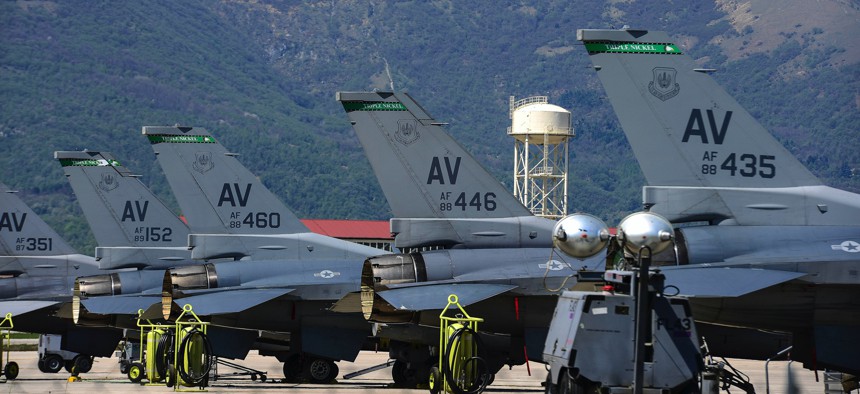
F-16 Fighting Falcons sit on the flightline at Aviano Air Base, Italy, April 19, 2018. U.S. Air Force / Airman 1st Class Ryan Brooks
The Wrong Way to Gauge Readiness
Too much focus on mission capable rates misses the larger and more important picture.
The Defense Department places tremendous importance on the concept of readiness. The degree to which the U.S. military is ready to fight is how leaders can assure lawmakers, policymakers and the public that they are prepared to do their job defending and deterring conflicts.
But there is a problem in how readiness is measured. One metric in particular is gaining far more attention than it should, among all that actually goes into determining military readiness. It’s called “mission capable rates,” or MC rates, which is the percentage of inventory of any given piece of military hardware that’s ready for use, from fighter jets to rifles and night-vision goggles.
Many recent writings by pundits, defense reporters, and in Government Accountability Office reports wrongly imply that mission capable rates are the key indicator of readiness for U.S. combat units. This is misguided. There are three major elements of readiness: materiel, personnel, and training. Mission capable rates represent only a small fraction of materiel readiness. They are hardly indicative of the overall readiness of a combat unit to succeed in its designed operational capability for achieving military objectives.
In fact, mission capable rate is a lagging indicator, a fleet management tool for resource and maintenance planning. When examined in a historical sense, especially when aggregated across a service-wide fleet, the metric is of little utility in measuring the overall readiness of a combat unit. Therefore, claiming the Department of Defense is less capable or ready based solely on MC rates misrepresents actual readiness levels.
One reason for all the attention is that in 2018, Defense Secretary Jim Mattis established a mission capable rate goal for specific aviation assets across the service branches. The stated purpose of the effort — ensuring the department produced maximum fighting capacity from existing inventory, while maintaining lethality — relied on multiple industry benchmarks that measure supply chain effectiveness, depot throughput, operating cost, and mission capability. The year-long effort centered on making progress toward the 80 percent mission capable rate goals Mattis established.
While the so-called MC80 effort produced some benefits, the narrow focus on tactical-level mission capable rates on a small group of fighter aircraft platforms forced resourcing tradeoffs that did not translate to improved readiness across the force. Limited resources were flowed into a small subset of the total force, hurting our service branches’ ability to achieve and sustain readiness levels across all of the other weapons platforms necessary to meet National Defense Strategy imperatives. The focus on a single equipment-related metric also hindered the department’s much-needed modernization efforts. Ultimately, the MC80 effort was not expanded to include other fleets such as ships or ground combat vehicles, or extended beyond its one-year interval.
The Defense Department places tremendous focus on the ability of units to restore sufficient readiness levels, and uses a wide range of measurements to assess our ability to execute National Defense Strategy-required missions. While mission capable rate measurement is one tool in the toolbox, by itself it does not demonstrate the nation’s readiness to respond in a crisis.
A better, more comprehensive, and valid approach to assessing readiness would embrace numerous other factors to measure each military service branch’s ability to present forces, including equipment availability, numbers and experience levels of operator and maintenance personnel, aircraft or other platform sortie or mission generation, hours per-pilot and per-month, availability, and levels of threat-representative training. This broader set of metrics enables us to assess and validate a more complete picture of readiness across the total force.
Mission capable rates alone are simply not an accurate measure of our military’s readiness levels. Our comprehensive suite of readiness measures, coupled with adequate and predictable annual defense appropriations, enables us to realize increased combat readiness to conduct the full range of military operations. The real challenge ahead is to sustain the substantial progress we’ve made in recovering from the 10 years of damaging 2011 Budget Control Act funding caps. For that, we need the full and continuing support of Congress.



